 |
||
|
|
|
|
|
|
||
|
|
||
|
|
||
|
|
||
|
|
||
|
|
||
|
|
||
|
|
||
|
|
||
| Featured
Book |

Featured Article
Addressable TV Advertising
by Lawrence Harte
Featured in the November 2009 issue of IPTV Magazine |
With the use of the targeted ad revenue success of Internet marketing, implementing addressable advertising into TV systems can multiply broadcaster ad revenues by 4 to 10 times (or more). However, implementing full addressable advertising has complexity and capacity challenges. The traditional TV advertising business model of selling ad spots for specific TV programs is shifting to dynamically selected (well targeted) ads that may have a sophisticated set of campaign rules and requirements. The good news is that the Society of Cable Telecommunication Engineers (SCTE) has created (and is continuing to develop) a set of industry specifications that define how addressable advertising services can be provided. |
|
|
|
|
|
|
|
Addressable Advertising Systems Matching the right ads to the right customer at the right time can involve many rules and decisions. Ad campaigns define what promotional opportunities advertisers are willing to pay for, including territory , system type and times of insertion. Advertisers may define what types of content they want their ads inserted in and how they may be seen in proximity to other ads. The broadcaster may have a varying number of promotional opportunities based on programming type and network affiliate agreements. Subscriber viewing habits and preferences may be available to help select the types of ads that may be desired. The SCTE has created a series of industry specifications (known as the SCTE 130 Series) that work together to provide addressable advertising services. Advertising Decision Service (ADS) Ad decision service (ADS) is a set of rules and processing functions that determine which ads are selected to be combined with other program content and how they will be combined. Decisions made by the ADS may be specific (date and time) or they may be based on a set of conditions and parameters (such as geographic zones and subscriber profile information). The ADS system is described in SCTE 130-3. Content Information Service (CIS) Content information service (CIS) is a system that identifies and manages descriptive data (metadata) for programs and advertising messages. The CIS system allows for the searching, discovery, and alerting of the availability of media items and their classifications. The CIS system is described in SCTE 130-4. |
Placement Opportunity Information Service (POIS) Placement opportunity information service is system and process that identifies and provides descriptions of placement opportunities for media (such as the availability to insert ads). A TV broadcaster typically has several minutes of ad insertion opportunities for each hour of programming. Placement opportunities are content and time specific so they can vary based on the type of network, geographic location or other associated content attributes. The POIS may contain requirements and attributes that may include which platforms may be used, ownership rights, and policies that are used to coordinate the placement of media. The POIS system is described in SCTE 130-5. Subscriber Information Service (SIS) Subscriber information service is a system or process that can store, process and access subscriber information that can assist in the selection of ads. SIS enables behavioral targeting of ads. Because SIS captures personal information from viewers, SIS systems may be required to control access and limit identification information to ensure viewer privacy. SIS is defined in SCTE specification 130-6. Figure 1.1 shows how SCTE has created an addressable advertising system that uses several different information systems to assist in the selection of TV ads. The advertising decision system (SCTE 130-3) identifies and coordinates the insertion of ads into media systems which may include linear TV advertising. Ads and program content can be classified and described in the content information system (SCTE-4). The ADS can register with the CIS system to search for content and receive alerts when specific types of content are available. |
 |
|
 |
|
|
Figure 1.1 Addressable TV Advertising System |
|
|
The placement opportunity information service (SCTE 130-5) can be used to identify when advertising inventory is available for use. The subscriber information service (SCTE 130-6) can be used to obtain information related to subscriber activities (preferences or viewing habits). Addressable Advertising Revenue According to the Television Bureau of Advertising (TVB), TV advertising revenue in the United States in 2008 was approximately $48 billion, which was a 0.4% decrease from the TV ad spending in 2007 [1]. According to the Interactive Advertising Bureau (IAB), Internet advertising revenue in the United States in 2008 was $23.4 billion compared to $21.2 billion spent in 2007 (a 10.6% increase) [2]. One advertising trend shows the shifting of ad spending from broadcast TV into communication channels (such as the Internet) that are more targeted and measurement. TV system operators can modify their systems to take advantage of this trend. By upgrading TV advertising systems so they can target ads (addressable advertising) and provide improved measurement and reporting (even more than Internet advertising in some cases), dramatic increases in TV advertising revenue can be achieved. The increases can come from charging higher fees per insertion (higher cpms), obtaining revenue from new advertisers (from ad bidding networks), and new ad revenue streams (from new types of advertising services). Higher Revenue CPMs Highly targeted ads can lead to higher ad cpms. By targeting ads to specific viewer groups, the results of advertising can be dramatically improved. For example, only sending tampon commercials to women viewers in certain age groups increases the response rates and provides new ad insertion opportunities for commercial insertions to other viewer groups. Advertisers may improve their response rates by 5 to 10 times through precisely targeting their audience groups. In addition to better targeting viewers with ads, ad viewing information may be gathered and used to indicate how viewers responded to the ad. To protect the privacy of viewers, anonymized set top boxes can be used. Anonymized STBs gather selection and channel changing (tuning metrics) data, and ad interactions (option selections) with content, all without revealing the viewer’s identity. |
Adding the ability to precisely target ads to groups of viewers and provide detailed viewing measurements will help to motive advertisers to pay much higher cpm rates. Ad Bidding Networks Advertisers may compete (bid) for access to available advertising spots and they may have paid or committed to pay an amount that is determined by the number of viewers reached by the broadcaster. Ad bidding systems dynamically allocate promotional ad opportunities to pre-approved advertising companies. One of the key advantages to using ad bidding networks for TV advertising is that it lowers the barrier to entry for advertisers. It makes TV advertising more like Internet advertising where the advertiser can setup their own ad campaigns and budgets. While the minimum TV ad bidding budget may be low, the actual ad spend per cpm is very high. Lower entry costs result in more advertisers, more competition and higher ad revenues. Another advantage of ad bidding networks is that they automatically coordinate the selection and placement of ads. Once the automation process is setup, it can dramatically reduce the advertising system’s operational costs. New Ad Revenue Streams Addressable advertising offers new types of advertising services which can create new revenue streams for the operator. Like Internet advertising, some of the transaction based revenue sources can have high transaction value (possibly over $20 per event). Some of the new types of ad revenue streams include placing ads in on demand programming, overlay advertising and downloaded ad applications. Advertising in on demand programs (such as movies on demand) can be performed as pre-rolls, post rolls and in program advertisements. Because the viewer is already streaming the program from the media server, the insertion of ads into on demand programs may require only relatively simple software upgrades. An overlay ad is a promotional message that is overlaid on top of another media item. An example of an overlay ad is the insertion of a company or brand logo, or a message onto part of a video display. A benefit to overlay advertising is the assurance that viewers will see the advertising messages. When overlay ads are used, viewers cannot skip or fast forward through promotional messages. |
|
|
|
|
Ad applications, which are a new type of advertising service, are downloadable software programs that an initiate an advertising message (such as within a STB) when certain conditions exist. Ad triggers may occur during the viewer’s selection of certain types of media, allowing for highly targeted advertising experiences. For example, if a viewer has selected to watch a TV program on car repair, a car repair ad may appear. Upgrading to Addressable Advertising Upgrading to addressable advertising involves the addition of software intelligence and equipment, the installation of more ad servers, and, potentially the addition of more bandwidth to the distribution network. Addressable Advertising Systems Addressable advertising systems can dynamically setup campaigns, select ads, coordinate ad insertion and track the ad consumption (viewing and interaction). Addressable ad insertion systems may be capable of managing ad in broadcasts (linear advertising) or programs (on demand). Addressable advertising systems operate on a system of rules rather than simple ad insertion orders. They use databases (usually in relatively simple XML text formats) that identify content, promotional opportunities and subscriber preferences. Addressable ad insertion systems may be designed to integrate with existing (legacy) TV ad systems. Some of the companies that provide addressable advertising systems include Black Arrow (www.blackarrow.tv, Big Band Networks (www.bigbandnet.com), and SeaChange (www.schange.com). Ad Server Capacity Ad server capacity is a measure of the ability of a storage device to select and deliver ads. Ad server capacity may be defined using a combination of media storage capacity (storage of ad media), device streaming capacity (in Mbps or Gbps), and the number of streams that can be simultaneously delivered (media processing). The number of ad requests that can be processed over a period of time is also important as ad requests in addressable advertising systems may simultaneously occur. The ability to process the requests and to find the media file and start streaming can be limited. |
Ad servers have traditionally relied upon the use of disk storage. The relatively long disk access times (seek time) for disk storage ad servers can limit their capacity to rapidly service many ad requests. To overcome the long seek time challenge, ad servers are transitioning into flash memory servers, eliminating the disk access challenge. Ad Transmission Bandwidth The transmission bandwidth that is needed for addressable ad delivery is related to the number of streams and the average bandwidth per stream. For networks with tens of thousands of customers, distribution networks cannot provide simultaneous streams. Some of the solutions to the bandwidth that is required for ad delivery include moving ad servers towards the edge of the network, increasing media compression and preloading ads. By installing ad servers closer to the edge of the network, the need to provide many simultaneous streams through the distribution network is no longer present. Viewers are connected to a local ad server. For unexpected occurrences of high addressable ad activity, the media server might be configured to deliver ads in lower resolution formats. While this may result in some adjustments in ad revenues, it may help to ensure that all advertisers reach their desired target audiences. Preloading ads into the memory of set top boxes can be performed before the ads are scheduled to be inserted. When the ad spot comes on, the system can simply redirect the viewer’s media source to the memory inside the STB. This allows ad servers to transfer the media between times that require the delivery of many simultaneous ads. References: 1. “2008 TV Ad Revenue Figures,” Television
Bureau of Advertising 2. “IAB Internet Advertising Report,”
|
Sponsored
by IPTV Tutorials IPTV
Basics Training Courses Is your company listed? It's FREE! Upcoming Industry Shows and Events |



